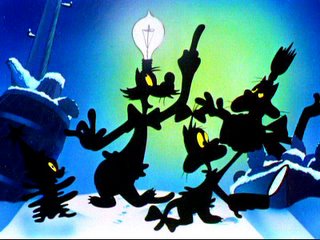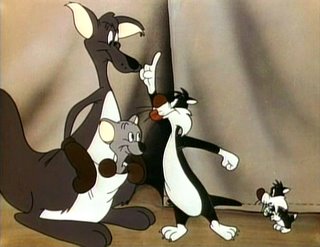
The layout artist won't draw every character pose that makes up the animator's performance. The animator has to take the layout and background and then in turn - stage each and every one of his poses so that the whole performance of the character is easy to see.

Here's what Frank and Ollie have to say about that:
Staging for Animators - making the poses read.
Control The Audience's Attention With Clear Posing
It's the animator's job to control the audience, to make sure the viewer's eye doesn't wander around the screen wondering what is happening. A good animator knows which parts of every action are the most important and forces he viewer to take notice of them and catch the meaning that the animator intended. This requires great skills and drawing tools.Here's what Frank and Ollie have to say about that:





Silhouettes read better than jumbles
http://johnkstuff.blogspot.com/2006/05/animation-school-lesson-5-line-of.html





The ingredients of a good Silhouette are :
LINE OF ACTION:

The general overall pose of the the character tells you the direction of the character which in turn can tell you many other things-his attitude, what he is doing, which character is leading the action...
NEGATIVE SHAPES:

The negative shapes within your pose tell you what the character is doing.
HIERARCHY OF DIRECTION:

Some part of your pose is more important than the rest of the pose. Maybe a character is pointing. Then you have to make that part of your sillo more obvious than the rest of the body. Draw attention to it.

Don't distract from the pointing by having other parts of the body stick out of the silhouette as much as or more than the pointing action. Have the rest of the body being pulled along by whichever part is causing the action.

When everything is moving all the time, it becomes hard to tell what is happening. You can see this problem in many late 30s cartoons, when animators were outdoing each other by having the characters constantly change shape and each part of the body had secondary actions, overlapping action, tons of squash and all the animation tools happening all the time and competing with each other for attention. Watch some "Captain and The Kids".
By the 40s, most top animators learned that good clear poses were more effective in selling a story than constant random motion.
 Strong and obvious lines of action and silhouettes were very popular and expertly done in the 1940s.
Strong and obvious lines of action and silhouettes were very popular and expertly done in the 1940s.
 40s cartoons based the entertainment more on action, while 50s began focusing more on dialogue and design.
40s cartoons based the entertainment more on action, while 50s began focusing more on dialogue and design.Subtle Lines Of Action - it happened in the 50s
 By the 50s, many animators began toning down their lines of action and bold silhouettes. They didn't abandon them completely, just made them more subtle.
By the 50s, many animators began toning down their lines of action and bold silhouettes. They didn't abandon them completely, just made them more subtle.  Brilliant 50s Jones design- full of classic principles and tricky contrasts.
Brilliant 50s Jones design- full of classic principles and tricky contrasts.The more "modern" character designs tended to have more straight lines and angles, so it naturally makes an animator tend towards less obviously rounded organic posing.
 Characters tended to stand up straight more. These Harvey Eisenberg 60s comics still have all the classic drawing principles evident, but the balance of them has changed. The poses are less obvious, but still very clear.
Characters tended to stand up straight more. These Harvey Eisenberg 60s comics still have all the classic drawing principles evident, but the balance of them has changed. The poses are less obvious, but still very clear.

 As the good animators toned down their principles, new animators came into the business who didn't understand them at all and couldn't see the subtleties in the more experienced animators' work. This led quickly to the disappearance almost altogether of lines of action and clear silhouettes.
As the good animators toned down their principles, new animators came into the business who didn't understand them at all and couldn't see the subtleties in the more experienced animators' work. This led quickly to the disappearance almost altogether of lines of action and clear silhouettes.http://johnkstuff.blogspot.com/2007/05/upa-vs-wally-5-upa-bred-worse.html
Why Man Learns From The Past
Now and then, someone will write in the comments that young artists don't need tools. They just need their own God-given creativity and their beautiful natural-born styles. They needn't hamper themselves with knowledge and techniques that were learned through trial and error by experts over decades. The young genius artist wants to start from scratch and make all the same mistakes that thousands of more talented artists had long ago learned to correct.
Every artist of course has the right to do whatever he wants. Every builder does too. You could poopoo hammers as cramping your creativity and try to punch nails into wood as you attempt to build a house in a completely new way without even a plan. It's not against the law or anything. - But good luck in ever finishing it or having it stand up by itself.
But it eludes my reasoning why anyone would want to choose to have absolutely no control over their finished products. Skills, practice, knowledge and tools put you way ahead of your competitors.
You have a much wider freedom of creative choices if you understand the basic tools of your trade.
Being able to clearly and creatively stage your poses, makes you more capable of getting your audience to feel and see what YOU want them to see. Posing is one of many important tools that gives you more control.
To rebel against tried and true effective tools when you have never been able to handle them yourself in the first place seems very self-defeating to me.
It's one thing if you are Picasso or John Hubley and you want to veer off into abstraction, but it's not the same thing for a smelly little graffiti artist who just can't draw but wants you to believe he has a unique style.


